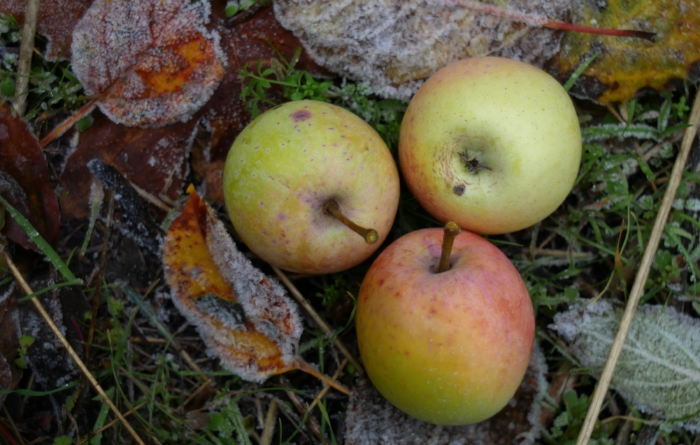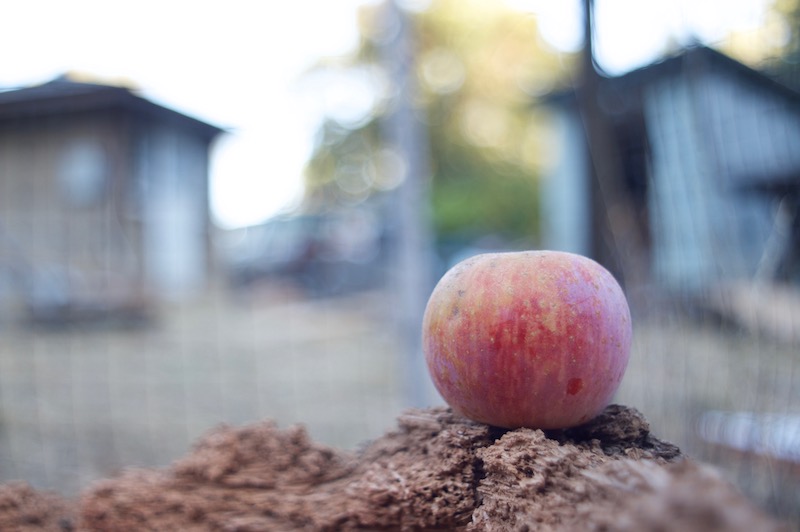Yesterday I pulled out two varieties of apple from storage to taste, GoldRush and Pomo Sanel. It is one thing to find apples that keep for a long time without rotting, but that does not mean they will retain flavor or keep a good eating texture. Some apples will actually gain flavor with maturity, at least to a point, but most will lose flavor.
GoldRush
These were picked later than they should have been. I suspect if picked earlier, they would store a little better.
Gold Rush is well known for keeping very well, even without refrigeration. I have specimens from the refrigerator as well as from a cold room. All were picked late The apples from the fridge have retained some crunch, though they are not like the super crispy apples that you might find in a grocery store this time of year. Those apples are stored under controlled conditions with inert gasses to hold them in stasis until they are shipped to stores. The flavor has developed well in storage. When this apple is first picked it is edgy and harsh. I wouldn't say the flavor has improved from a month ago, but it is still complex and full with enough acidity to get my attention.
The apples stored in the shed were wrinkled and drying out. None though showed any signs of decay. Their texture is rubbery, with no hint of mealiness. The flesh compresses, then starts to break into pieces. The flavor and sugar are concentrated and delicious. I could see storing a lot of these and drying the oldest left over fruits in the spring. They would be half dry already.
All in all GoldRush is an excellent home orchard apple, and should be considered in any small collection of varieties. It combines long keeping, flavor, good cultural traits and some disease resistance. Out of all my dwarf interstem trees, it has the best, easiest to care for, form and high vigor.
Pomo Sanel
Pomo Sanel is a rare apple, barely known among a few fruit enthusiasts in this area, let alone anywhere else.
Pomo Sanel was stored in the refrigerator. It gradually lost it's crispness. It is not meally or mushy, at least not yet, but all remnants of crispness are gone. I was hoping it would go rubbery instead, but it didn't. The flavor has changed, less complex, more appley, banana still prominent. There is some acidity, but the sprightliness is gone. I could eat plenty of these, but it is not equal to it's fridge mate at this point and will surely decline from here. Like GoldRush, it was probably harvested too late and might do better in storage if picked at an earlier stage, as soon as it reaches full size, but before the sugars develop.
Pomo Sanel, still a little lean and green, but closer to where it should probably be picked for long storage
Pomo Sanel's most interesting attribute is it's late ripening in late December or usually January here. Given it's high quality straight off the tree at that season, it's a winner here in my climate. Whether it will store well enough beyond 4 weeks or so if harvested earlier and treated well remains to be seen, but keeping up with the likes of Pink Lady and GoldRush is a tall order and it no doubt won't. A really good storage apple can be very good, even excellent, but it's still not the same as a tree ripened apple kissed by frost and brought into it's prime in cold weather, nor is the whole eating experience the same. That paradigm is where Pomo Sanel and hopefully it's offspring will shine. I sent out many seeds this winter all around the world, so everyone cross your fingers and we'll check in about 8 or 10 years from now.
I'm interested in breeding with both of these and have made some crosses. If I'm lucky, some of those seedling crosses might bear fruit this year.











